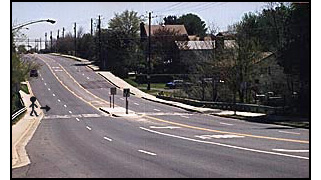Vision or Hearing?? The concepts and skills needed to recognize Situations of Uncertainty for gap judgment are just as important for people who use vision to cross streets as it is for those who use hearing, and many of the principles are the same for both. However using sounds for crossing can be more complex than using vision, and includes issues that you may not have considered (heck, we even need to talk about what "quiet" really means!).
For that reason, Section 1 focuses more on issues of using hearing than it does with using vision. But keep in mind that the principles for recognizing and dealing with Situations of Uncertainty are the same regardless of whether you are looking or listening for vehicles. Starting with Section 2, the Self-Study Guide deals with teaching these concepts and skills to students who use vision to detect the vehicles as well as those who use hearing.
So . . . let's get started! We'll begin by explaining some terms.
What does it mean to have a crossing with no stop sign or traffic signal?
- Right: There are no stop signs or traffic signals within a block of this crossing in suburban Washington, DC.
- Below: These intersections each have a stop sign for the street beside the pedestrians, but not for the street that they are facing to cross.
Thus, even though the pedestrians are all at intersections that have traffic control, they are facing uncontrolled crossings.
- Left below: At roundabouts, there are no stop signs or traffic signals for traffic approaching the crosswalks.
- Right below:
This woman is crossing a channelized right-turning lane at an intersection that has a traffic signal for the vehicles on the other side of the island behind her,
but there is no signal or stop sign for the lane she is crossing.
This Self-Study Guide is about crossings with no stop sign or traffic signal. Other terms are "crossings with no traffic control" or "uncontrolled crossings."
These crossings can be found everywhere -- downtown, suburban and rural areas. Most of them are found at intersections that DO have stop signs or traffic signals, but those signals or stop signs are not for every crossing at that intersection. It's those crossings that we're talking about -- crossings that have vehicles passing through without being controlled by any stop sign or traffic signal.
 Examples of these crossings are shown in the photos here:
Examples of these crossings are shown in the photos here:




